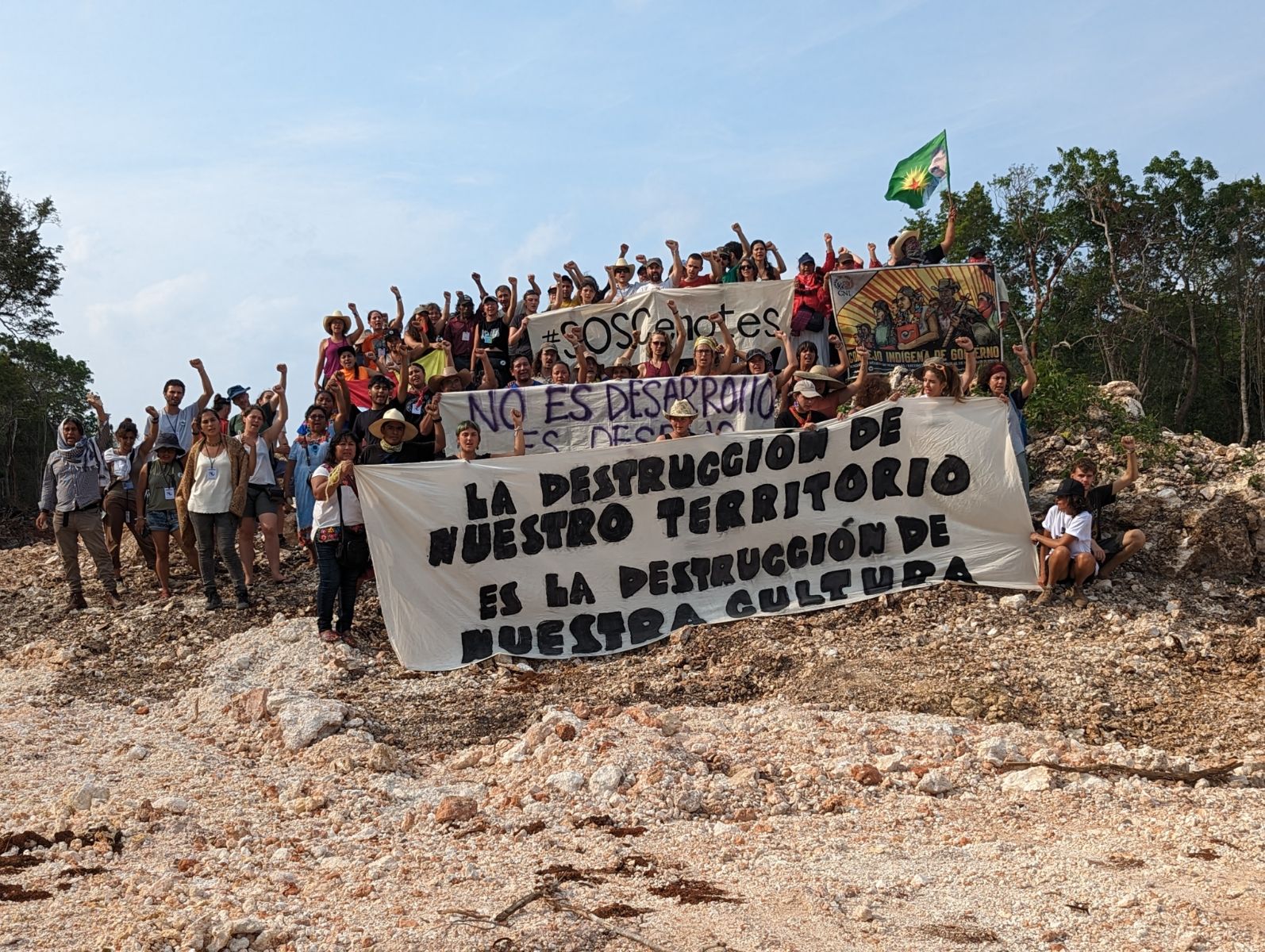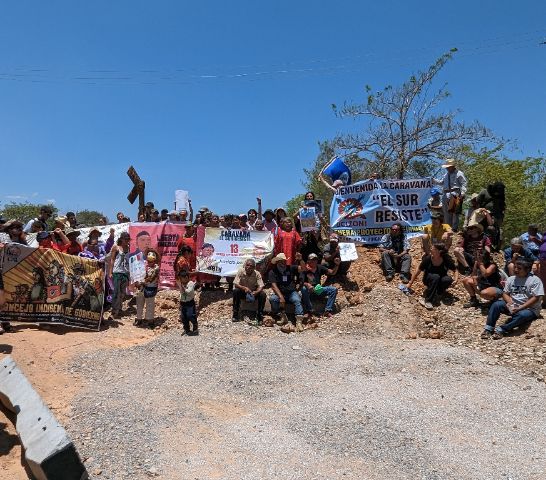
The San Francisco Bay Area, in California, United States, is well known for being home to technology companies such as Google and Facebook. However, a few kilometers from them, in the city of Oakland, is the Zapatista education and information center known as Comité de Apoyo a Chiapas ?Chiapas Support Committee? facing them.
One of the heads of the committee, Arnoldo García, told Peninsula 360 Press about the work they do throughout the state, along with Vanessa Nava, who was part of the delegation sent to Mexico to participate in the most recent caravan El Sur Resiste in Mexico.
The Committee is an organization made up of members who adhere to the principles of the Sixth Declaration of the Lacandon Jungle and international solidarity with the Zapatista movement, supported by indigenous peoples in Chiapas, Mexico. They have supported and accompanied the construction of autonomy in the territory they control since 1994.
Currently, Garcia, a poet, musician and community activist, heads the committee.
"I am not president of anything, we only have a board of directors due to State requirements and I just stayed there, for more than 10 years," García said.
The committee provides education and information to the Californian public about the Zapatistas, the situation in Chiapas, and the community struggles in Mexico through public events, the bulletin Chiapas Update, email lists, page Facebook and his blog. Currently, the greatest support they provide is to autonomous educational system: construction of schools, supply for teachers and students.
Every time some of the Committee they go to Chiapas, buy from the Zapatista cooperatives at the price that the producers set, selling these same products in the San Francisco Bay Area and returning all the profits to the Zapatista communities.
García grew up in a family of farm workers of Mexican-P?urhépecha origin who migrated between Mexico and the US. His experiences organizing with other youth and peasants throughout his life led him to actively participate in the protection of the rights of the undocumented in the American Union.
"In the US they put African-Americans and migrants in the same corner, in the end it is the same State and the same police that oppresses minorities," García commented.
Her work addresses the struggles for racial and immigration justice, restorative justice against capitalist borders, for landless Chicano Mexicanidad in the United States, and solidarity with indigenous movements. Since 1994, García has followed the Zapatista movement.
«The Zapatistas? García continues reflecting? they have placed a lot of emphasis on recognizing Chicanos and Mexicans in the US as part of their struggles, as well as the peoples of North America.”
García commented that the Zapatistas opened spaces where they ratified that, in effect, Another world is possible.
«In 1994, when the Zapatistas came out "in the public light", they had these same values and principles as various groups in the US, but that courage to say, "we are going to do our thing and organize ourselves", was the last straw. the glass".
When it was the first international meeting, García was not part of the Committee. However, he attended, and it was again in 1996. Whether with or without Garcia, the organization sends a delegation to Chiapas at each International Meeting.
«We try to make them know the reality of the indigenous and Zapatista peoples who live in Mexico without romanticizing anything. On the contrary, so that they learn other forms of struggle, and not only know those that have been done in the US, "García commented.
The committee seeks ways to organize binationally to create fighting dialogues between Mexico and its neighbor to the north. At the International Meeting of Women Who Fight, held in 2019, the Committee sent Ohlone women, one of the native peoples of the northern coast of California, and in this way connect the different groups that resist against the different forms of dispossession by the State. , since the Zapatistas advocate another possible world.
They also organize annual and monthly events in San Francisco and Oakland, for example, they have a vigil every December 22 where they commemorate the Acteal massacre, in which 45 families and people from the Tzotzil community lost their lives in Chiapas in 1997. Likewise, On the 26th of every month, the committee goes to the Mexican Consulate on Folsom Street to show solidarity and demand justice for the 43 disappeared from Ayotzinapa and the paramilitary violence in Mexico.
The committee recently sent a delegation to the El Sur Resiste caravan in Mexico and to the caravan's culminating event, the International Encounter.
"I'm not going, but the delegation of Vanessa Nava and Caitlin Manning who we send will help us learn directly from the experiences of the National Indigenous Congress ?CNI? and the Zapatistas in order to strengthen our solidarity," Garcia said.

Delegation in the South Resiste
Nava joined the caravan in Puente Madera, in the state of Oaxaca, on April 26.
The caravan The South Resists summoned by the CNI toured the Mexican southeast with the purpose of making visible the territories that will be affected by the implementation of extractivist megaprojects, which are the Mayan Train and the Corridor transisthmic. Likewise, andshe was looking foreither boost the organization of communities, collectives, towns, and organizations to create concrete strategies and connect the different struggles they experience.
Nava was born in Chicago, Illinois, and spent her childhood in Guerrero, Mexico, where her family is. Attending the caravan was a personal matter with the land and Mexico, as she came to deeply connect with the land when her parents worked in the fields planting corn.
She returned to her hometown to attend high school, where she began organizing to help undocumented students. He then studied Communications, Sociology and Anthropology at Loyola University Chicago. There he continued to participate in organizations along with other students to pressure the approval of the DREAM Act. He later applied for a master's degree in digital art in San Francisco, where he now resides.
Nava startedeither to get involved in the Chiapas Support Committee in 2019. Although she already knew about the Zapatista movement, it wasn't until California that she started going to events and being an active member.
In the caravan, Nava sought to learn the ways in which the various groups, organizations, activists, and community leaders who resist the imposition of the Trans-Isthmic Corridor and the Mayan Train in Mexico fight and resist. Thus, to continue resisting the megaprojects that exist in California and other US states.
In the United States, the "Maya Train" began in the 1800s with the construction of transcontinental rails. Not so long ago, in 2016 the construction of the bullet train in California called the California High Speed Rail Authority was approved, whose magnitude is similar to the Transisthmian corridor in Mexico.
California's high-speed rail project has vowed to do better than past megaprojects, lessening the impact it will have on the communities it will run through from Los Angeles to the San Francisco Bay Area.
However, what they have built in the Central Valley of California is already impacting communities of farmers. Like the Mayan Train, not only have the communities been displaced, but also the water, the flora and fauna of the region, are being affected.
While the construction of the bullet train in California is on hold due to lack of financing, other megaprojects continue, such as the Kestone XL pipeline, which the Lakota peoples of South Dakota have resisted.
Nava explains that activism in the United States could learn a lot from the Zapatistas, and that binational solidarity is critical to fighting for life in both territories.
"Putting heart into the fight, that is what is sometimes lacking around here and being consistent with the land, the water and living beings," said Nava.
Likewise, she seeks to spread the word to the new generations in California and share how they can defend the territory where they live, learning from the compass.
"It is crucial not to forget about deitherwhere we are, remember our memories and share our skills with the new generations to face injustices, create autonomy and different ways of walking to build a better world with love for life”, expressedeither.
You may be interested in: Raising the debt ceiling divides opinions due to possible effects for Americans


